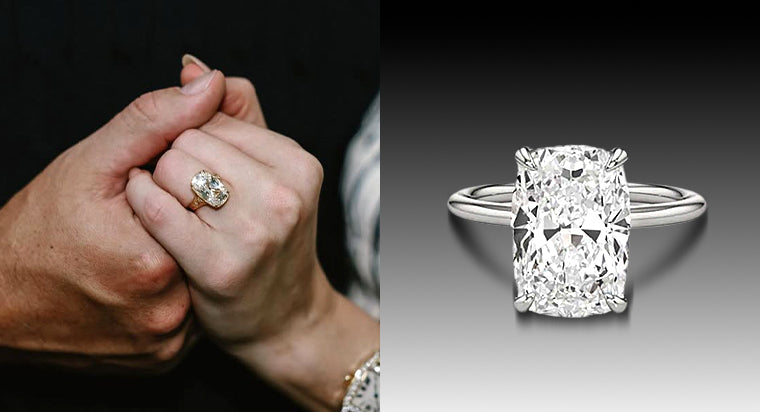Weighing the Pros and Cons of Yellow Gold Engagement Rings

When you think of a wedding band or engagement ring, two metals likely come to mind - yellow gold and silver metals, such as platinum. Known for its timeless look, warm aesthetic, and versatile coloring, yellow gold is an excellent foundation for diamond engagement rings.
However, while yellow gold engagement rings have long been cherished for their classic appeal, they, like any other precious metal, come with their own set of considerations. Before choosing yellow gold for one of the most precious pieces of jewelry you'll ever wear, it's important to consider this timeless metal's positive and negative aspects.
TABLE OF CONTENTS
It is Subjective to Your Preferences
Yellow gold is often thought of as classic. Many jewelry pieces are created from yellow gold, making the material an ever-popular choice. If you already have gold items and regularly wear yellow gold jewelry, a yellow gold engagement ring will likely fit right in with your style. It's also ideal for traditional brides who desire a conventional and charming look. Vintage lovers will also appreciate yellow gold's ability to enhance an antique-inspired ring rather than clash with its designs.
Still, yellow gold, with its warm and rich hue, may not align with everyone's taste. Personal preferences vary; some individuals may lean towards the cooler tones of white gold or platinum. These metals are usually considered more modern, making them great for an edgy or alternative bride. Recognizing the subjective nature of taste is crucial when discussing the downsides of yellow gold.
It is Prone to Scratching
One practical consideration is the susceptibility of yellow gold to scratching, especially in higher karat weights. Pure gold is a very soft metal, and the more of it you have in your ring, the more likely your engagement ring is to show wear and tear. The karat weight determines how much pure gold is in your ring. For example, 24 karats are considered pure gold. In comparison, 18 karats means about three-quarters of the ring is pure gold, and the other quarter is an alloy, usually copper or silver. While the alloy detracts from the value, it also strengthens the ring. For engagement rings, 18k or even 14k is typically recommended to enhance strength and durability, as this type of jewelry is frequently worn 24/7.
Still, for those leading active lifestyles or seeking a ring that withstands wear and tear, even the smallest risk of showing damage may pose too great a concern. Exploring alternative metals like platinum, known for its durability, becomes essential in such cases.
The Possibility of Allergies and Skin Sensitivities
While pure gold is hypoallergenic, the alloys used to create yellow gold in various karat weights are not. As mentioned above, 18kt gold has as much as 25% alloy in its composition. The alloy can include copper, nickel, or silver, some of which can trigger allergic reactions in some individuals. When considering yellow gold metal for an engagement ring, it's essential to be aware of potential allergies or skin sensitivities.
It Requires Maintenance and Polishing
No engagement ring metal is truly immune from regular care and maintenance. However, yellow gold is softer than alternative choices like platinum. Therefore, its luster may require regular maintenance. Periodic polishing becomes necessary to eliminate scratches and retain the metal's shine. In some cases, you can clean and polish your ring at home. However, deeper scratches require a professional jeweler's expert care. This upkeep may be viewed as a downside for those seeking a low-maintenance option for their gold diamond ring.
It is Moderately Priced
While yellow gold stands as a classic choice, the fluctuating price of gold can impact the overall cost of the engagement ring. This consideration becomes significant, especially for individuals who might find the price of gold to be a downside compared to more budget-friendly alternatives.
Nevertheless, the price of your yellow gold engagement ring can vary by karat weight, and a lower karat weight could help you find a ring that suits your budget. Although, we wouldn't recommend going below 14kt. Still, yellow gold is often a less expensive option than platinum, which tends to be the most costly.
It Isn't Immune to Fashion Trends
Engagement ring preferences regarding the materials and design are not immune to fashion trends. Currently, yellow gold is still a popular option. It has fallen slightly recently, with modern favorites like platinum sometimes taking the lead. Nevertheless, according to the International Gem Society, yellow gold remains the most popular metal for an engagement ring, making it highly unlikely yellow gold engagement rings will ever fall completely out of style.
However, yellow gold's popularity will ebb and flow, and you might be concerned about your ring appearing outdated in the future. Balancing timeless elegance with current trends becomes a delicate consideration.
Great Compatibility with Gemstones
For the most part (though not all gem gemstones harmonize equally with yellow gold), yellow gold is a great canvas for engagement ring gemstones. It's especially fitting for diamonds, as they are also a classic choice, and together, the yellow gold and diamonds can enhance the timeless look of your ring. What's more, yellow gold may even make less colorless diamonds appear whiter and brighter, allowing you to purchase a slightly more inexpensive stone at a lower color grade. However, yellow gold also works well for colorful stones like emeralds and rubies.
Still, some individuals may prefer alternative metals that enhance the brilliance of specific gemstone colors. Yellow gold can be paired with less vibrant gems, like amethyst, but cooler metals may help paler gems pop more. This factor underscores the importance of considering the chosen gemstone in conjunction with the metal.
It Has a Moderate Perceived Value
Gold is undoubtedly a precious metal and has been for some time. Gold has been coveted and cherished throughout the centuries, usually used to identify people of wealth and power. Yellow gold is often held in better esteem than white gold, silver, or other metals commonly used for fine jewelry.
Nevertheless, the perceived value of yellow gold may not be as high as platinum or other rarer metals. Of course, perceived value depends on fluctuating factors, like popularity and the ever-changing price of metals. However, this could be an important consideration for those who emphasize the material's rarity and exclusivity.
Is Yellow Gold Right for Your Engagement Ring?
Choosing an engagement ring is a deeply personal decision that depends on various factors. You should consider your lifestyle, tastes, chosen design and gemstones, budget, and how much importance you place on perceived popularity and value before making a decision. Ultimately, yellow gold's upsides and downsides should be viewed within the context of your priorities, needs, and preferences. But remember, whether you choose yellow gold or another metal, the sentimental value attached to your engagement ring will often surpass any perceived disadvantages.









